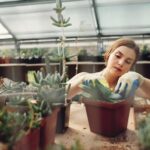Are you looking for container gardening ideas for vegetables? Container gardening is a fantastic option for growing your favorite veggies, especially if you have limited outdoor space or poor soil quality. In this article, we will explore the benefits of container gardening and provide you with creative ideas and tips to help you start your own successful vegetable garden in containers.
Container gardening offers a range of benefits, making it an attractive option for many gardeners. Whether you live in an apartment with a small balcony or have limited outdoor space, containers allow you to grow vegetables without the need for a traditional garden plot. Additionally, container gardens can be positioned in ideal sunlight and soil conditions, leading to healthier plant growth and higher yields.
In the sections that follow, we will discuss choosing the right containers for different types of vegetables, selecting the ideal vegetables for container gardening, and providing basic guidelines on starting and maintaining a successful container garden. We’ll also explore innovative container ideas and space-saving techniques to maximize your vegetable harvest. Whether you’re new to gardening or looking to expand your growing space, this article will provide valuable insights and inspiration for cultivating delicious vegetables in containers.
Choosing the Right Containers
When it comes to container gardening ideas for vegetables, choosing the right containers is crucial for the success of your garden. There are various options to consider, including pots, raised beds, and hanging planters. Each type of container has its own advantages and considerations, so it’s important to select the best containers for the specific types of vegetables you want to grow.
Pots
Pots are a popular choice for container gardening as they come in a variety of sizes and materials, making them versatile for growing different vegetables. When selecting pots for vegetables, consider the size and depth based on the root structure of the plants. For example, larger pots are suitable for tomatoes and peppers, while shallow pots work well for herbs and lettuce.
Raised Beds
Raised beds are another great option for growing vegetables in containers, particularly if you have limited space or poor soil quality in your outdoor area. They provide ample room for root growth and allow better drainage. Additionally, they can be customized to fit your space and gardening needs.
Hanging Planters
For those looking to maximize vertical space, hanging planters are an excellent choice. They are ideal for trailing plants like cherry tomatoes or cascading herbs such as rosemary or thyme. When choosing hanging planters for vegetables, make sure they have adequate support and drainage to prevent waterlogged soil.
Selecting the right containers for your vegetable garden is essential in ensuring that your plants thrive. By considering factors such as size, material, and drainage capabilities, you can create a successful container garden that yields bountiful harvests of fresh produce throughout the season.
Selecting the Ideal Vegetables for Container Gardening
When it comes to container gardening ideas for vegetables, selecting the right vegetables to grow is crucial for a successful harvest. Not all vegetables thrive in containers, so it’s important to choose varieties that are well-suited for this type of gardening. Fortunately, there are several vegetables that do exceptionally well in containers, making them ideal choices for those looking to start a container garden.
Tomatoes
Tomatoes are one of the most popular vegetables to grow in containers. They require a large pot with good drainage and ample sunlight. Determinate varieties are best suited for containers as they stay relatively compact and don’t require staking.
Peppers
Peppers, both sweet and hot varieties, are also excellent candidates for container gardening. They thrive in warm and sunny conditions, so be sure to place your pepper plants in a location that receives plenty of sunlight.
Lettuce
Lettuce is a great option for container gardening, especially if space is limited. It can be grown in shallow pots or window boxes and prefers cooler temperatures, making it an ideal choice for early spring or late summer planting.
Carrots
Believe it or not, carrots can be successfully grown in containers with the right depth and soil quality. Look for shorter carrot varieties that are better suited for growing in confined spaces.
Herbs
Herbs like basil, parsley, chives, and mint are perfect candidates for container gardening. They don’t require a lot of space and can thrive on a sunny windowsill or balcony. They also make excellent companion plants for other vegetables.
With these vegetable choices, you’ll be well on your way to creating a bountiful container garden filled with fresh produce right at your fingertips. Remember to consider the specific growing requirements of each vegetable when planning your container garden to ensure the best possible results.
Container Gardening Basics
Container gardening is a fantastic and versatile way to grow your favorite vegetables, especially if you have limited outdoor space or poor soil quality. Here are some helpful tips for getting started with your own container garden.
Step 1: Choosing the Right Containers
When it comes to container gardening ideas for vegetables, the first step is choosing the right containers. Consider the size of the mature plant and look for containers that will accommodate this size. Pots, raised beds, hanging planters, or even repurposed items like wooden crates or barrels can be great options for growing vegetables. Here are the best containers for different types of vegetables:
- Tomatoes: Large pots or fabric grow bags
- Lettuce: Shallow window boxes or salad boxes
- Carrots: Deep pots or cylindrical containers
- Herbs: Small individual pots or a long planter box
Step 2: Soil Selection and Planting
Choosing the right soil is crucial for successful container gardening. Look for a high-quality potting mix that provides good drainage and aeration for your plants’ roots. When planting your vegetables, make sure to follow spacing recommendations provided on seed packets or plant labels to ensure that each plant has enough room to grow.
Step 3: Watering and Fertilizing
Proper watering is essential for container vegetable gardens. Check your plants regularly and water deeply when the top inch of soil feels dry. Additionally, consider using a slow-release fertilizer specific to vegetables to provide essential nutrients for healthy growth.
By following these simple steps and considering these container gardening ideas for vegetables, you’ll be well on your way to enjoying an abundant harvest from your own container garden.
Creative Container Ideas
When it comes to container gardening ideas for vegetables, there are countless creative and innovative options to explore. One unique approach is to repurpose items that you may already have on hand, such as wooden crates, barrels, and even recycled plastic bottles. Not only does this offer a sustainable and eco-friendly solution for container gardening, but it also adds a charming and rustic aesthetic to your garden space.
To spark your creativity, here are some container gardening ideas using repurposed items:
- Wooden Crates: Old wooden crates can be transformed into beautiful planters for growing vegetables. Simply line the crate with landscaping fabric or plastic to prevent soil from leaking out, fill it with nutrient-rich potting mix, and start planting your favorite vegetables.
- Barrels: Upcycled barrels make excellent containers for larger vegetables like tomatoes or peppers. Cut the top off of an old barrel, add drainage holes, and fill it with a mixture of compost and soil for a bountiful harvest.
- Recycled Plastic Bottles: Get resourceful by upcycling plastic bottles into small herb planters or vertical garden fixtures. Cut the bottles in half, poke holes in the bottom for drainage, and hang them in a sunny spot to cultivate your own mini vegetable garden.
By incorporating repurposed items into your container garden, not only are you reducing waste by giving new life to old materials, but you’re also adding character and personality to your gardening space. These container gardening ideas offer a practical and cost-effective way to grow a variety of vegetables while showcasing your creativity and environmental consciousness.
Space-Saving Techniques
When it comes to container gardening, space can often be a limiting factor, especially for those who live in urban or small living areas. However, there are several space-saving techniques that can be employed to maximize the limited space available for growing vegetables in containers. Two popular methods are vertical gardening and companion planting.
Vertical gardening involves growing vegetables on a vertical surface, such as a trellis, wall, or fence, rather than horizontally in traditional garden beds. This technique allows for the efficient use of space by utilizing upward rather than outward growth. Vegetables like cucumbers, tomatoes, and beans thrive in vertical gardens and can be trained to grow upwards with the help of support structures like stakes or cages.
Companion planting is another space-saving strategy that involves growing compatible plants together in the same container. By pairing vegetables that have mutually beneficial relationships, such as tomatoes and basil or carrots and lettuce, gardeners can make the most of limited space while also promoting healthier growth and minimizing pest problems. For example, planting basil next to tomatoes not only saves space but also enhances the flavor of the tomatoes and acts as a natural deterrent to pests.
In addition to these techniques, using tiered plant stands or hanging planters can also maximize vertical space. These options provide additional room for growing a variety of vegetables without taking up valuable ground space.
By implementing these space-saving techniques in container gardening, even those with limited outdoor or indoor space can enjoy a bountiful harvest of fresh vegetables right at their fingertips.
| Space-Saving Techniques | Description |
|---|---|
| Vertical Gardening | Involves growing vegetables on a vertical surface rather than horizontally. |
| Companion Planting | Involves growing compatible plants together in the same container. |
| Tiered Plant Stands/Hanging Planters | Maximizes vertical space for container gardening. |
Troubleshooting Common Issues
One of the most common challenges that container gardeners face is dealing with pests, diseases, and environmental factors that can negatively impact the health and growth of their vegetables. Pests like aphids, caterpillars, and spider mites can wreak havoc on plants, while diseases such as powdery mildew and blight can quickly spread and compromise an entire container garden.
Additionally, environmental factors like extreme heat, cold temperatures, or inconsistent watering can also pose threats to the success of a vegetable container garden.
To address these issues, it’s essential for container gardeners to stay vigilant and proactive in monitoring the health of their plants. Regular inspection of leaves, stems, and soil can help detect any early signs of pest infestation or disease development.
It’s also crucial to practice good sanitation by removing any affected plant parts or using natural remedies like neem oil or insecticidal soap to control pests. In cases of disease outbreaks, applying fungicides or adjusting watering schedules may be necessary to prevent further spread.
Furthermore, implementing preventive measures can help mitigate potential issues in container gardening. This includes practicing crop rotation by changing the placement of vegetables in containers each growing season and providing proper air circulation by spacing out plants accordingly. Utilizing mulch or companion planting with pest-repelling herbs like basil and marigold can also offer a natural defense against common pests.
Overall, being aware of these common issues and utilizing effective solutions will contribute to a successful and thriving container garden for growing vegetables.
| Issue | Solution |
|---|---|
| Pests (aphids, caterpillars) | Regular inspection; natural remedies such as neem oil or insecticidal soap |
| Diseases (powdery mildew, blight) | Sanitation; use of fungicides; adjusting watering schedules |
| Environmental factors (heat/cold) | Practicing crop rotation; proper air circulation; mulching/companion planting |
Harvesting and Maintenance
In conclusion, container gardening offers a versatile and accessible way to grow vegetables in various urban and suburban settings. With the right containers, careful selection of vegetables, and a few creative ideas, anyone can enjoy the benefits of growing their own produce in limited space. From tomatoes and peppers to lettuce and herbs, there are plenty of options for container gardening. By following some basic guidelines for soil choice, watering, and fertilizing, even novice gardeners can find success.
As with any type of gardening, container gardening comes with its own set of challenges, such as pests, diseases, and environmental factors. However, by knowing how to troubleshoot common issues that arise in container gardening, gardeners can overcome these challenges and take proactive steps to maintain a healthy and thriving vegetable garden. Additionally, understanding when and how to harvest vegetables grown in containers is essential for ensuring optimum flavor and nutrition.
In summary, by providing useful tips on selecting the right containers, choosing the best vegetables for containers, offering innovative container gardening ideas like vertical gardening or repurposed items as planters, space-saving techniques like companion planting, addressing common issues that may arise during container gardening including pests, diseases or environmental factors, discussing maintenance tips for maintaining a healthy garden life span.
Readers will gain valuable insights into the world of container vegetable gardening by reading articles that cover all aspects from start to finish. And with this knowledge on hand they would be well-equipped to begin their own successful journey into container gardening.
Frequently Asked Questions
What Vegetables Grow Well Together in a Container?
Some vegetables that grow well together in a container include tomatoes, basil, and onions. These three plants complement each other’s growth habits and create a diverse and productive container garden.
What Vegetables Are Good to Grow in Containers?
Many vegetables are good to grow in containers, but some of the best options include lettuce, peppers, carrots, and radishes. These vegetables don’t need a lot of space to thrive and are well-suited for growing in containers on patios or balconies.
What Is the Best Container for a Vegetable Garden?
The best container for a vegetable garden is one that provides enough space for the plants to grow and has proper drainage. Consider using large plastic or ceramic pots with drainage holes to ensure the health and vitality of your vegetable plants.

Welcome to my gardening blog! I am passionate about plants and enjoy sharing my knowledge and experiences with others. In this blog, I will write about everything related to gardening, from tips on how to get started to updates on my own garden projects.





